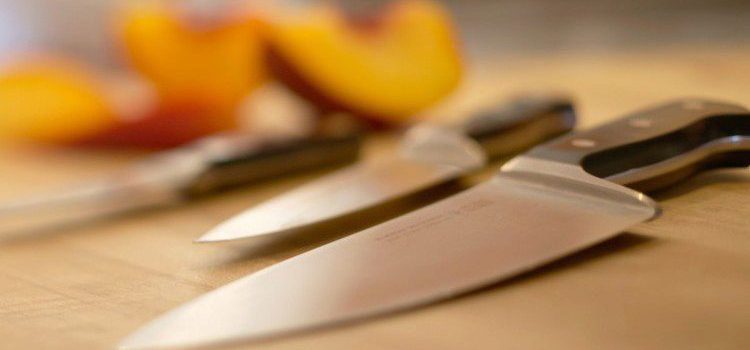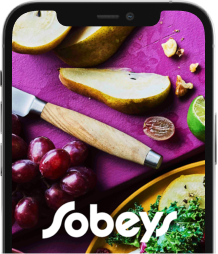Kitchen Knives come in all shapes and sizes, but you really need only four to take care of the vast majority of your food prep: a chef’s knife, a paring knife, a boning knife and a serrated knife. These four tools will make light work of everything from peeling and trimming to dicing and slicing. You’ll also save time and minimize food waste, and your dishes will look even better on the plate.
Knowing the basics about the care and keeping of knives will help you extend their life span, too. Ready to learn? Let’s cut to the chase!
The Four Must-Have Knives
Chef’s Knife
What it is: A large, general utility knife, usually with an eight- to 12-inch (approximately 20- to 30-centimetre) blade, which curves gently upward from base to tip.
What it’s for: This knife is best put to work chopping, slicing, dicing and mincing pretty much everything—vegetables and fruits, meat and fish.
How to use it: For best control, grip the blade with your thumb and index finger, then curl your other three fingers around the handle. Use a rocking motion, rather than slapping the blade up and down, to make your cuts. (That’s what the curve in the blade is for!)
Mistakes to avoid: It’s best not to use this knife for carving poultry, for butchering, or for removing the thick skins of large vegetables. It’s also not ideal for finicky tasks, such as coring a tomato, that require a small knife with a more delicate blade.
Shopping tips: Make sure you hold the knife before buying and see how it feels in your hand—do you like the weight and feel of it? People with smaller hands may prefer a smaller blade, but don’t shy away from a long one just because it may seem intimidating—it will offer more versatility, speed and efficiency.
Paring Knife
What it is: A small knife with a thin blade of three to four inches (approximately 7.5 to 10 centimetres) long that tapers to a sharp point.
What it’s for: This knife is designed for removing the skins of fruits and vegetables, and for making tiny, precise cuts in meat and fish. You can use the paring knife for vegetable carving, too, or to remove the eyes of potatoes. This is the knife you should reach for when deveining shrimp or sectioning citrus.
How to use it: For meat and poultry, use a paring knife like a scalpel for finer jobs such as removing chicken wings from the breast. Like an extension of your thumb and forefinger, it can be used with a light touch to peel or cut small pieces of fruit and veg, without the need for a cutting board.
Mistakes to avoid: This knife is designed for peeling and trimming, so avoid using it to chop, dice or mince—the blade is so small it will make your task more labour-intensive. And be sure not to use this type of knife to break or cut through bones when you’re butchering—it won’t endure such heavy labour.
Shopping tips: Besides a basic straight blade, there are slight variations in the blades available in paring knives, including one with a curve (the “bird’s beak”), designed for peeling curved fruits, and one with a serrated edge, ideal for cutting tomatoes.
Boning Knife
What it is: A thin and agile knife with some flexibility in the blade for cutting around the curves of bones. The blade of a boning knife ranges in length from six to eight inches (approximately 15 to 20 centimetres).
What it’s for: This knife will trim the flesh from the bones of raw or cooked poultry, meat or fish, and do finer work after carving.
How to use it: Slide this knife through meat as close to the bone as possible, allowing the knife to do the work. (If you’re using too much arm strength, it’s time to sharpen the blade.) Use smooth, flowing motions to separate flesh from the bone.
Mistakes to avoid: Don’t cut through bones with this knife. Cutting through joints and cartilage, however, is OK.
Shopping tips: If you’ll be using this knife mainly for poultry and fish, go for a more flexible blade. Stiffer blades work best for red meats. In general, seek out a model with a thinner blade.
Serrated/Bread Knife
What it is: A knife that has a long blade with saw-like teeth, designed for cutting with a back-and-forth motion.
What it’s for: With its gripping edge, this is the best knife for slicing bread, tomatoes and melons safely and cleanly.
How to use it: Cut even slices of the same thickness, using a gentle sawing motion. Be sure to cut all the way through the bottom crust or skin. Pan-baked loaves of bread look best cut straight, and baguettes at an angle.
Mistakes to avoid: Don’t use your bread knife to cut vegetables such as zucchini, carrots and potatoes; the blade will make messy cuts and ruin the overall look of the dish. When slicing bread, use only gentle downward pressure to avoid squishing the loaf.
Shopping tips: Select a knife with a thin, scalloped edge that tapers gently from the thickest part of the blade. Of all the knives you buy, this is the one where you can economize, since it takes less of a pounding than the others in your kit.
Stay Sharp
It’s actually safer to work with a sharp knife than a dull one, because a sharper one is less likely to get stuck or need you to exert a lot of pressure. To sharpen a non-serrated knife you’ll need a sharpening steel, which is a special rod made from a kind of steel that’s harder than your knives. Hold the sharpening steel vertically in your hand and anchor it on a level countertop. Be sure to firmly grip the steel below the handle guard to avoid getting cut. With your other hand, hold the knife horizontally, blade edge toward you and crossing the steel at a 25- to 35-degree angle (just be consistent in the angle you choose for each side). Stroke the knife in long sweeping motions down the steel from heel to tip, making the same number of strokes on each side, so that the knife is sharpened evenly.
The steel can do fine-tuning, but it won’t perform miracles, so when your blade gets particularly dull or nicked, take it to a knife or kitchen store for professional sharpening. Alternatively, you can use a sharpening stone—water- or oil-lubricated—to restore your knife’s edge. This is only necessary on occasion for the average home cook.
To keep your knives sharp longer, work with wooden or plastic chopping boards, rather than glass, marble, bamboo, acrylic or slate ones. The board should be made of a softer material than your blades.
Also avoid chopping through large bones, as this can chip and damage the blades of knives. (The exception is the cleaver, if you have one, as it is specially designed for butchery.)
And remember: the dishwasher is not your knife’s friend! The long exposure to steam and humidity will dull blades fast. Wooden handles will also end up splitting, as they expand and contract from the heat and moisture. Instead, wash your knives carefully by hand, then dry and store them as soon as possible, rather than leaving them to dry slowly in a rack with other kitchen tools.
Store knives in such a way that the blades are not in contact with one another, to minimize dulling. A knife block with horizontal slots, separate sheaths or a case is ideal.
Know Your Cuts
The size and shape of the pieces of an ingredient affect the look, taste, texture and cooking time of a dish, so it’s important to get your cuts right. Remember to trim the ends of vegetables—and peel or core them, if required—before you start chopping. This vocabulary list will help you follow recipes as intended.
Large dice: Cubes of three-quarter inches (two centimetres). Large chopping is generally used for rustic stews and casseroles, for soup stock, and for vegetables that will later be mashed or puréed.
Medium dice: Cubes of one-third inch (one centimetre). Soups often require this bite-sized cut. It can be useful for potato salads, too.
Small dice: Cubes of about a quarter inch (half a centimetre). This cut is popular for ingredients in meat sauces, such as bolognese.
Brunoise: Cubes of about an eighth of an inch (three millimetres). Brunoised vegetables are generally sautéed until golden-brown.
Julienne: Pieces should be long, like matchsticks, and about an eighth of an inch (three millimetres) thick. This cut is often used for appetizers and Asian-style salads.
Mince: Pieces should be very finely diced. Mincing is often used to create a heap of garlic or ginger.
Slice: Pieces should be cut in one direction (straight or at an angle), into flat discs or slices. You can slice bread, meats, fruits and vegetables. Round slices are often called discs or rondelles.
Shred (chiffonade): When you chiffonade herbs and leafy greens, you create ribbons by rolling a small pile of larger leaves (such as basil or spinach) then slicing through them finely in one direction.
Peel: A peeler or paring knife is the best tool for peeling veggies and fruits such as potatoes, squash, plums and peaches. You will need a knife rather than a peeler for thicker skins, such as citrus.
Zest: To remove just a thin layer of citrus skin (the coloured portion, not the white), use a peeler or a grater. The zest imparts intense flavour to dishes such as sorbets and cakes.



